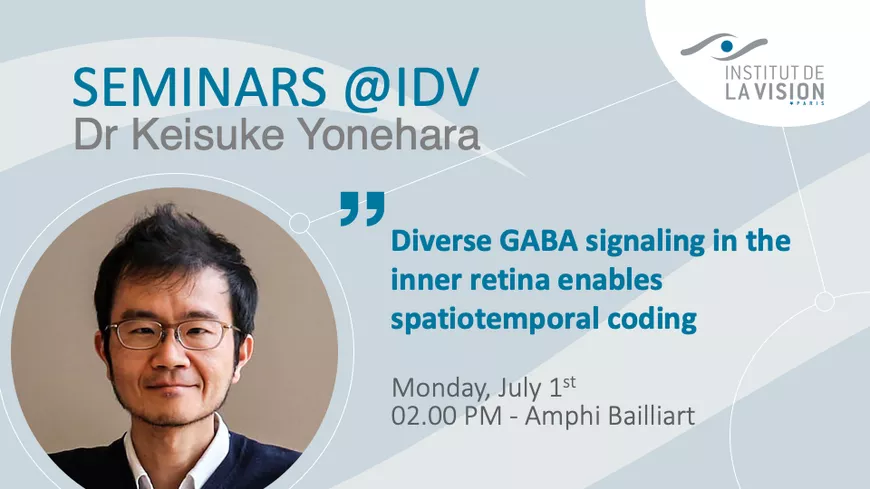Diverse GABA signaling in the inner retina enables spatiotemporal coding
Invited by Serge Picaud, Pr Keisuke Yonehara, (National Institute of Genetics, Mishima, Japan) will be giving a speech on July, Monday 1st et 02.00 PM.
RDV in the Amphithéâtre Bailliart, 3rd floor of the Hôpital national des 15-20.

GABA (γ-aminobutyric acid) is the primary inhibitory neurotransmitter in the mammalian central nervous system (CNS). There is a wide range of GABAergic neuronal types, each of which plays an important role in neural processing and the etiology of neurological disorders. However, there is no comprehensive understanding of this functional diversity, due to the lack of genetic tools to target and study the multitude of cell types. Here we perform two-photon imaging of GABA release in the inner plexiform layer (IPL) of the mouse retina using the newly developed GABA sensor iGABASnFR2. By applying varied light stimuli to isolated retinae, we reveal over 40 different GABA-releasing neurons, including some not previously described. Individual types show unique distributions of synaptic release sites in the sublayers comprising the IPL, allowing layer-specific visual encoding. Synaptic input and output sites are aligned along specific retinal orientations for multiple neuronal types.
Furthermore, computational modeling reveals that the combination of cell type-specific spatial structure and unique release kinetics enables inhibitory neurons to suppress and sculpt excitatory signals in response to a wide range of behaviorally relevant motion structures. Our high-throughput approach provides the first comprehensive physiological characterization of inhibitory signaling in the vertebrate CNS. Future applications of this method will enable interrogation of the function and dysfunction of diverse inhibitory circuits in health and disease.
About Keisuke Yonehara
Keisuke Yonehara received his PhD in the laboratory of Dr. Masaharu Noda at the National Institute for Basic Biology, Okazaki Japan, where he genetically identified a subtype of direction-selective ganglion cells in the mouse retina. To learn retinal physiology, he worked as a postdoc in the laboratory of Dr. Botond Roska at the Friedrich Miescher Institute for Biomedical Research (FMI), Basel, combining two-photon imaging and trans-synaptic viral tracing to characterize the development and function of direction-selective circuits in the mouse retina. In particular, he found that the congenital nystagmus gene Frmd7 is required for the development of retinal direction selectivity and optokinetic reflex. With a grant from ERC, he established his own group at the Danish Research Institute of Translational Neuroscience (DANDRITE), Aarhus University, Denmark in 2015 to work on the development and function of neural circuits in the retina, superior colliculus, and cortex. In 2021, he became a tenured Professor at the National Institute of Genetics, Mishima Japan, where he expanded his research program to develop gene therapies to treat serious visual and motor genetic diseases.
